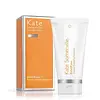What's inside
What's inside
 Key Ingredients
Key Ingredients

 Benefits
Benefits

 Concerns
Concerns

 Ingredients Side-by-side
Ingredients Side-by-side

Water
Skin ConditioningLactic Acid
BufferingSilica
AbrasiveGlycine Soja Oil
EmollientPectin
Emulsion StabilisingCetearyl Alcohol
EmollientCarica Papaya Fruit
Skin ConditioningCeteareth-20
CleansingCetyl Alcohol
EmollientPhenoxyethanol
PreservativeDehydroxanthan Gum
Emulsion StabilisingGlyceryl Stearate
EmollientPEG-100 Stearate
Salicylic Acid
MaskingLactobacillus/Pumpkin Ferment Extract
Skin ConditioningAlcohol Denat.
AntimicrobialSorbic Acid
PreservativeCinnamal
PerfumingMel
EmollientCitrus Aurantium Bergamia Fruit Oil
MaskingEugenol
PerfumingPotassium Sorbate
PreservativeLimonene
PerfumingLinalool
PerfumingLavandula Angustifolia Oil
MaskingBeta-Carotene
Skin ConditioningAloe Barbadensis Leaf Juice Powder
Skin ConditioningBromelain
Skin ConditioningPapain
Skin ConditioningRetinyl Palmitate
Skin ConditioningTocopheryl Acetate
AntioxidantCinnamomum Cassia Leaf Oil
MaskingAcetic Acid
BufferingPogostemon Cablin Leaf Oil
MaskingPelargonium Graveolens Flower Oil
MaskingAniba Rosaeodora Wood Extract
MaskingCitrus Aurantium Dulcis Peel Oil
MaskingCI 75810
Cosmetic ColorantWater, Lactic Acid, Silica, Glycine Soja Oil, Pectin, Cetearyl Alcohol, Carica Papaya Fruit, Ceteareth-20, Cetyl Alcohol, Phenoxyethanol, Dehydroxanthan Gum, Glyceryl Stearate, PEG-100 Stearate, Salicylic Acid, Lactobacillus/Pumpkin Ferment Extract, Alcohol Denat., Sorbic Acid, Cinnamal, Mel, Citrus Aurantium Bergamia Fruit Oil, Eugenol, Potassium Sorbate, Limonene, Linalool, Lavandula Angustifolia Oil, Beta-Carotene, Aloe Barbadensis Leaf Juice Powder, Bromelain, Papain, Retinyl Palmitate, Tocopheryl Acetate, Cinnamomum Cassia Leaf Oil, Acetic Acid, Pogostemon Cablin Leaf Oil, Pelargonium Graveolens Flower Oil, Aniba Rosaeodora Wood Extract, Citrus Aurantium Dulcis Peel Oil, CI 75810
Water
Skin ConditioningButylene Glycol
HumectantTrisiloxane
Skin ConditioningPetrolatum
EmollientCarthamus Tinctorius Seed Oil
MaskingGlycerin
HumectantPPG-2 Myristyl Ether Propionate
EmollientC10-30 Cholesterol/Lanosterol Esters
EmulsifyingLimnanthes Alba Seed Oil
Skin ConditioningLaureth-7
EmulsifyingC13-14 Isoparaffin
EmollientPolyacrylamide
Beeswax
Emulsion StabilisingC12-15 Alkyl Benzoate
AntimicrobialCaprylyl Glycol
EmollientCetyl Alcohol
EmollientCitrus Aurantium Dulcis Peel Oil
MaskingCitrus Limon Peel Oil
MaskingCymbopogon Citratus Leaf/Stem Oil
MaskingEthylene Brassylate
MaskingEthylhexylglycerin
Skin ConditioningGlyceryl Stearate
EmollientHexylene Glycol
EmulsifyingLavandula Hybrida Oil
EmollientLinalool
PerfumingLinalyl Acetate
MaskingLinum Usitatissimum Seed Oil
PerfumingLitsea Cubeba Fruit Oil
MaskingMalic Acid
BufferingOctanal
PerfumingOlea Europaea Fruit Oil
MaskingPEG-100 Stearate
Persea Gratissima Oil
Skin ConditioningPhenoxyethanol
PreservativePhoenix Dactylifera Fruit Extract
EmollientPhytosphingosine
Skin ConditioningPhytosterols
Skin ConditioningPyrus Malus Fruit Extract
Skin ConditioningQuercetin
AntioxidantRosa Canina Fruit Oil
EmollientSodium Hyaluronate
HumectantSodium Hydroxide
BufferingWater, Butylene Glycol, Trisiloxane, Petrolatum, Carthamus Tinctorius Seed Oil, Glycerin, PPG-2 Myristyl Ether Propionate, C10-30 Cholesterol/Lanosterol Esters, Limnanthes Alba Seed Oil, Laureth-7, C13-14 Isoparaffin, Polyacrylamide, Beeswax, C12-15 Alkyl Benzoate, Caprylyl Glycol, Cetyl Alcohol, Citrus Aurantium Dulcis Peel Oil, Citrus Limon Peel Oil, Cymbopogon Citratus Leaf/Stem Oil, Ethylene Brassylate, Ethylhexylglycerin, Glyceryl Stearate, Hexylene Glycol, Lavandula Hybrida Oil, Linalool, Linalyl Acetate, Linum Usitatissimum Seed Oil, Litsea Cubeba Fruit Oil, Malic Acid, Octanal, Olea Europaea Fruit Oil, PEG-100 Stearate, Persea Gratissima Oil, Phenoxyethanol, Phoenix Dactylifera Fruit Extract, Phytosphingosine, Phytosterols, Pyrus Malus Fruit Extract, Quercetin, Rosa Canina Fruit Oil, Sodium Hyaluronate, Sodium Hydroxide
Ingredients Explained
These ingredients are found in both products.
Ingredients higher up in an ingredient list are typically present in a larger amount.
Cetyl Alcohol is a fatty alcohol. Fatty Alcohols are most often used as an emollient or to thicken a product.
Its main roles are:
Though it has "alcohol" in the name, it is not related to denatured alcohol or ethyl alcohol.
The FDA allows products labeled "alcohol-free" to have fatty alcohols.
Learn more about Cetyl AlcoholCitrus Aurantium Dulcis Peel Oil is oil from the peel of an orange fruit.
Limonene and linalool make up the majority of oils from citrus peels. Limonene has a "citrus" fragrance. Citrus peels also contain flavonoids, which have anti-inflammatory properties.
Citrus peel is also a rich source of flavonoids. Flavonoids are natural antioxidants and help protect your skin against damage. Flavonoids are a group of compounds naturally found in vegetables and fruits.
The term 'fragrance' is not regulated in many countries. In many cases, it is up to the brand to define this term. For instance, many brands choose to label themselves as "fragrance-free" because they are not using synthetic fragrances. However, their products may still contain ingredients such as essential oils that are considered a fragrance.
Learn more about Citrus Aurantium Dulcis Peel OilGlyceryl Stearate is a mix of glycerin and stearic acid.
It is used to stabilize the mixing of water and oil ingredients. By preventing these ingredients from separating, it can help elongate shelf life. It can also help thicken the product's texture.
As an emollient, it helps soften skin and supports barrier-replenishing ingredients.
In cosmetics, Glyceryl Stearate is often made from vegetable oils or synthetically produced.
This ingredient may not be fungal-acne safe
Fun fact: The human body also creates Glyceryl Stearate naturally.
Learn more about Glyceryl StearateLinalool is a fragrance and helps add scent to products. It's derived from common plants such as cinnamon, mint, citrus, and lavender.
Like Limonene, this ingredient oxidizes when exposed to air. Oxidized linalool can cause allergies and skin sensitivity.
This ingredient has a scent that is floral, spicy tropical, and citrus-like.
Learn more about LinaloolPeg-100 Stearate is an emollient and emulsifier. As an emollient, it helps keep skin soft by trapping moisture in. On the other hand, emulsifiers help prevent oil and water from separating in a product.
PEGS are a hydrophilic polyether compound . There are 100 ethylene oxide monomers in Peg-100 Stearate. Peg-100 Stearate is polyethylene glycol ester of stearic acid.
Phenoxyethanol is a preservative that has germicide, antimicrobial, and aromatic properties. Studies show that phenoxyethanol can prevent microbial growth. By itself, it has a scent that is similar to that of a rose.
It's often used in formulations along with Caprylyl Glycol to preserve the shelf life of products.
Water. It's the most common cosmetic ingredient of all. You'll usually see it at the top of ingredient lists, meaning that it makes up the largest part of the product.
So why is it so popular? Water most often acts as a solvent - this means that it helps dissolve other ingredients into the formulation.
You'll also recognize water as that liquid we all need to stay alive. If you see this, drink a glass of water. Stay hydrated!
Learn more about Water